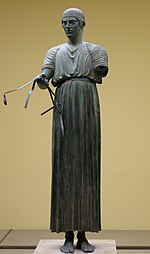Elgin Marbles

The Elgin Marbles or Parthenon Marbles are a series of ancient Greek sculptures of relief made from marble. They were originally part of the Parthenon temple in Athens but they were taken by Thomas Bruce, 7th Earl of Elgin in the early 1800s.
Many people, including the Greek government, have argued that Elgin stole the marbles and did not take them legally.[1] They are on display in the British Museum. The Greek government asked to have them back many times. In 2014 UNESCO offered to mediate but the museum declined. [2]
History of the removal
[change | change source]In Britain, the acquisition of the collection was supported by some,[3] while others, such as Lord Byron, likened Elgin's actions to vandalism or looting.[4] A UK parliamentary inquiry in 1816 decided that Elgin had got the marbles legally.[5] Elgin sold them to the British government in that year, after which they passed into the trusteeship of the British Museum.
References
[change | change source]- ↑ "Athens Guide - the Parthenon Marbles". Retrieved 2010-05-30.
- ↑ "The Parthenon Marbles - demands of the Greek Government". Retrieved 2010-05-30.
- ↑ Casey, Christopher (30 October 2008). ""Grecian Grandeurs and the Rude Wasting of Old Time": Britain, the Elgin Marbles, and Post-Revolutionary Hellenism". Foundations. Volume III, Number 1. Archived from the original on 13 May 2009. Retrieved 25 June 2009.
- ↑ Beard, Mary (2002). The Parthenon. London: Profile Books. pp. 11–15. ISBN 186197292X.
- ↑ "Great Britain. Parliament. House of Commons. Select Committee on the Earl of Elgin's Collection of Sculptured Marbles, Printed for J. Murray, by W. Bulmer and Co., 1816". Google ebook. 1816.

